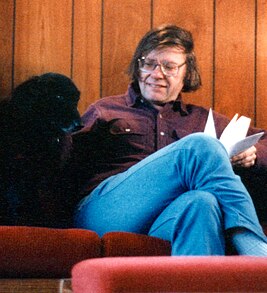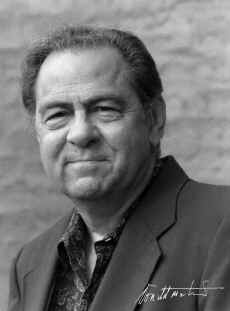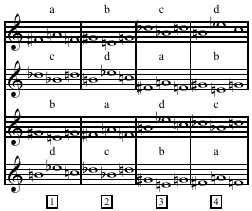Related Research Articles
In music, a tone row or note row, also series or set, is a non-repetitive ordering of a set of pitch-classes, typically of the twelve notes in musical set theory of the chromatic scale, though both larger and smaller sets are sometimes found.

Milton Byron Babbitt was an American composer, music theorist, mathematician, and teacher. He is particularly noted for his serial and electronic music.

Benjamin Aaron Boretz is an American composer and music theorist.
Mario Davidovsky was an Argentine-American composer. Born in Argentina, he emigrated in 1960 to the United States, where he lived for the remainder of his life. He is best known for his series of compositions called Synchronisms, which in live performance incorporate both acoustic instruments and electroacoustic sounds played from a tape.
In music a time point or timepoint is "an instant, analogous to a geometrical point in space". Because it has no duration, it literally cannot be heard, but it may be used to represent "the point of initiation of a single pitch, the repetition of a pitch, or a pitch simultaneity", therefore the beginning of a sound, rather than its duration. It may also designate the release of a note or the point within a note at which something changes. Other terms often used in music theory and analysis are attack point and starting point. Milton Babbitt calls the distance from one time point, attack, or starting point to the next a time-point interval, independent of the durations of the sounding notes which may be either shorter than the time-point interval, or longer. Charles Wuorinen shortens this expression to just time interval. Other writers use the terms attack interval, or, interval of entry, interval of entrance, or starting interval.

Donald James Martino was a Pulitzer Prize winning American composer.
The Austrian composer Arnold Schoenberg published four string quartets, distributed over his lifetime: String Quartet No. 1 in D minor, Op. 7 (1905), String Quartet No. 2 in F♯ minor, Op. 10 (1908), String Quartet No. 3, Op. 30 (1927), and the String Quartet No. 4, Op. 37 (1936).
Richard Swift was an American composer and music theorist.

Composition for Four Instruments (1948) is an early serial music composition written by American composer Milton Babbitt. It is Babbitt’s first published ensemble work, following shortly after his Three Compositions for Piano (1947). In both these pieces, Babbitt expands upon the methods of twelve-tone composition developed by Arnold Schoenberg. He is notably innovative for his application of serial techniques to rhythm. Composition for Four Instruments is considered one of the early examples of “totally serialized” music. It is remarkable for a strong sense of integration and concentration on its particular premises—qualities that caused Elliott Carter, upon first hearing it in 1951, to persuade New Music Edition to publish it.
The Group for Contemporary Music is an American chamber ensemble dedicated to the performance of contemporary classical music. It was founded in New York City in 1962 by Joel Krosnick, Harvey Sollberger and Charles Wuorinen and gave its first concert on October 22, 1962 in Columbia University's MacMillin Theatre. Krosnik left the ensemble in 1963. It was the first contemporary music ensemble based at a university and run by composers.
Carlton Gamer is an American composer and music theorist. He has taught at Colorado College, Princeton University, and the University of Michigan. He studied at Northwestern University and Boston University and privately with Roger Sessions.
The Fourth String Quartet by American composer Elliott Carter was composed in 1985–86 in New York City and Rome, and completed in June 1986. It was premiered on September 17, 1986 at Festival Miami, University of Miami, Florida by the Composers String Quartet.
Roger Sessions' Violin Concerto was composed between 1927 and 1935, and is scored for violin and orchestra.
String Quartet No. 2 (1954) is the second of six chamber-music works in the string quartet medium by the American composer Milton Babbitt.
String Quartet No. 3 is the third of six chamber-music works in the string quartet medium by the American composer Milton Babbitt.
String Quartet No. 5 is the fifth of six chamber-music works in the string quartet medium by the American composer Milton Babbitt.
String Quartet No. 6 is the last of six chamber-music works in the string quartet medium by the American composer Milton Babbitt.
All Set, for jazz ensemble, is a 1957 composition for small jazz band by the American composer Milton Babbitt.
Robert Miller was an American pianist and attorney.
References
- Mead, Andrew. 1984. "Recent Developments in the Music of Milton Babbitt". Musical Quarterly 70, no. 3 (Summer): 310–31.
- Swift, Richard. 1977. "String Quartet No. 4, 1970 by Milton Babbitt; String Quartet No. 3 by Seymour Shifrin". Notes, second series, 34, no. 1 (September): 203.